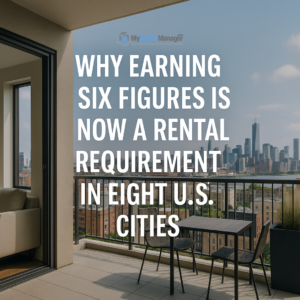The dream of living comfortably in a major U.S. city is becoming increasingly out of reach for many Americans. A recent report from Zillow, highlighted by Yahoo Finance, reveals a startling reality: renters now need to earn a six‑figure salary to afford the median rent in eight major metropolitan areas.
This marks a sharp increase from 2020, when only four metro areas required such high income levels. With rent growth far outpacing wage increases, even those earning over $100,000 annually are finding it difficult to secure housing without becoming rent-burdened.
The Rent Surge: What’s Driving It?
-
Pandemic Shifts: The COVID-19 pandemic caused a surge in rental demand, particularly as people sought larger spaces for remote work. This spike in demand coincided with a limited supply of available rentals, driving prices upward.
-
Supply Constraints: Many cities have failed to keep up with housing demand due to restrictive zoning, high construction costs, and regulatory hurdles.
-
Investor-Owned Properties: An increase in institutional investors buying single-family homes for rentals has tightened the market for affordable units.
-
Inflation: Broader economic inflation has raised the costs of property maintenance, taxes, and utilities, with landlords passing these costs to tenants.
Since 2020, median apartment rents have risen by roughly 29%, now averaging $1,858 per month, while single-family rental rates have skyrocketed nearly 43% to around $2,256 per month. Median household income, by contrast, has grown by just 22.5%—a gap that leaves many renters stretched thin.
The Cities Where $100,000+ Is Required
Eight metro areas now demand six-figure incomes just to stay below the 30% affordability benchmark, which recommends that no more than 30% of income should be spent on rent.
| Metro Area | Minimum Income Needed |
|---|---|
| New York City | $135,000+ |
| San Jose, CA | $136,500 |
| Boston, MA | $127,000 |
| San Francisco, CA | $124,000 |
| San Diego, CA | $123,000 |
| Los Angeles, CA | $119,000 |
| Miami, FL | $110,000 |
| Riverside, CA | $103,000 |
-
New York City tops the list, with the typical rent reaching levels that require an annual income of at least $135,000 to avoid being considered rent-burdened.
-
California dominates the list, with five metro areas where even high-income earners must carefully budget to avoid overspending on housing.
-
Miami and Riverside highlight that this affordability crisis isn’t confined to the coasts but is also hitting fast-growing Sun Belt cities.
Rent-Burdened America
Nationally, renters are now spending nearly 29.6% of their income on rent, compared to 27% just five years ago. While the difference might appear small, it represents billions of dollars diverted from savings, investments, and discretionary spending.
This squeeze impacts all aspects of life:
-
Savings and Homeownership: With less disposable income, renters find it harder to save for a down payment, delaying or completely derailing homeownership plans.
-
Lifestyle Adjustments: From cutting back on dining out to postponing major life events like marriage or having children, the cost of rent is forcing lifestyle trade-offs.
-
Emergency Funds: Renters have fewer safety nets for unexpected expenses, leaving them financially vulnerable.
Policy Responses and Challenges
Some cities and states are exploring or implementing measures to address these challenges:
-
Broker Fee Reforms: In New York and Massachusetts, legislative efforts aim to shift broker fees from renters to landlords, reducing upfront costs.
-
Rent Control and Caps: Cities like Los Angeles and San Francisco have implemented rent control measures, but critics argue that these policies alone do not solve the underlying issue of limited supply.
-
Affordable Housing Initiatives: Federal and state programs are increasing funding for affordable housing construction, though such projects take years to materialize.
However, these policy changes are not enough to match the rapid pace of rent increases. The affordability crisis is more than just a housing issue—it’s becoming a broader economic and social problem.
Affordable Alternatives
While major metropolitan areas remain costly, there are still markets where renters can live comfortably without a six-figure income. Cities like Buffalo, Oklahoma City, and Louisville have affordability thresholds as low as $55,000 to $57,000 annually.
These markets offer:
-
Lower rent-to-income ratios.
-
More opportunities to save and invest.
-
A lower cost of living overall, from groceries to transportation.
For renters willing to relocate, these smaller metro areas present an attractive alternative.
What Renters Can Do Now
-
Consider Relocation: If your job allows remote work or relocation, explore affordable markets where the cost of living is more manageable.
-
Negotiate Lease Terms: Some landlords are open to negotiations, especially in markets with high vacancy rates.
-
Track Policy Developments: Stay updated on local rental laws, broker fee changes, and tenant rights.
-
Budget Rigorously: Tools like zero-based budgeting or the 50/30/20 rule can help renters manage expenses more effectively.
-
Look Beyond Traditional Apartments: Co-living arrangements or renting in less trendy neighborhoods can sometimes yield substantial savings.
The Bigger Picture
The reality that $100,000 salaries are no longer sufficient in major U.S. cities is a wake-up call. The U.S. housing market is at a critical juncture, with both affordability and availability shrinking for renters of all income levels.
Unless wage growth accelerates or housing supply improves, we may continue to see more Americans forced to choose between living paycheck to paycheck or moving away from economic hubs entirely. The rise of remote work could offer a silver lining—allowing workers to earn high wages while living in more affordable regions.
Source: It takes a six‑figure salary to afford rent in more cities than ever before – Yahoo Finance

